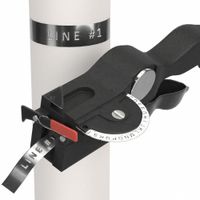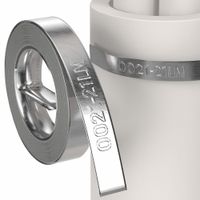Call +(254) 703 030 000 / 751 483 999 / 721 704 777
- Home
- Safety
- Signs Facility Identification Products
- Label Printers
- Embossing Label Printers Supplies
.....Read More
Frequently Asked Questions
What is an embossing label printer?
An embossing label printer is a device used to create raised, tactile labels by pressing characters into a strip of material, typically plastic or metal. This process involves a wheel with characters that, when pressed against the label material, create a raised impression. The resulting labels are durable and resistant to various environmental factors, making them suitable for both indoor and outdoor use.
Embossing label printers are often manually operated, requiring the user to turn a dial to select each character and then squeeze a handle to emboss the character onto the label strip. Some models may offer electric or battery-powered options for ease of use. The labels produced are typically adhesive-backed, allowing them to be easily affixed to surfaces.
These printers are commonly used in industrial settings, warehouses, and for personal organization tasks. They are ideal for labeling items that require long-lasting identification, such as cables, pipes, and storage containers. The raised characters are easy to read and can be felt by touch, which is beneficial for visually impaired individuals.
Embossing label printers are valued for their simplicity, reliability, and the professional appearance of the labels they produce. They do not require ink or toner, which reduces maintenance and operational costs. However, they are limited in terms of font styles and sizes compared to digital label printers. Despite these limitations, embossing label printers remain a popular choice for applications where durability and legibility are paramount.
How does an embossing label printer work?
An embossing label printer works by creating raised characters on a strip of material, typically plastic or metal, to produce durable and easy-to-read labels. The process begins with the user selecting the desired characters using a dial or keyboard on the device. Once the characters are selected, the printer uses a wheel or drum mechanism that contains dies corresponding to each character.
When the user presses a lever or button, the selected die is pressed against the label material with significant force. This pressure causes the material to deform, creating raised characters on one side and indented characters on the other. The embossing process does not use ink or toner, making the labels resistant to fading and suitable for various environments, including outdoor and industrial settings.
The embossed labels are typically fed through the printer from a roll or cassette. After embossing, the user can cut the label to the desired length using a built-in cutter. The labels often have an adhesive backing, allowing them to be easily affixed to surfaces.
Embossing label printers are valued for their simplicity, durability, and ability to produce labels that are both tactile and visually distinct. They are commonly used for labeling cables, pipes, equipment, and other items where long-lasting identification is necessary.
What materials can be used with embossing label printers?
Embossing label printers are designed to create raised text or designs on various materials, providing a durable and professional finish. The materials commonly used with embossing label printers include:
1. **Plastic Tapes**: These are the most common materials used with embossing label printers. They are typically made from durable, flexible plastics like polyester or vinyl, which can withstand various environmental conditions, making them suitable for both indoor and outdoor use.
2. **Metal Tapes**: Metal tapes, often made from aluminum or stainless steel, are used for applications requiring high durability and resistance to extreme conditions. They are ideal for industrial settings where labels need to withstand heat, chemicals, or abrasion.
3. **Foil Tapes**: These tapes are similar to metal tapes but are thinner and more flexible. They are used for decorative purposes or in situations where a metallic finish is desired without the need for the durability of thicker metal tapes.
4. **Paper Tapes**: Although less common, some embossing label printers can work with specially coated paper tapes. These are typically used for temporary labeling or in environments where the labels are not exposed to harsh conditions.
5. **Vinyl Tapes**: Vinyl is another popular material due to its flexibility and resistance to moisture and UV light. It is often used for color-coded labeling systems in various industries.
6. **Polyester Tapes**: Known for their strength and resistance to tearing, polyester tapes are used in environments where labels need to endure wear and tear.
Each material offers unique properties, making them suitable for different applications, from industrial labeling to home organization. The choice of material depends on factors such as the environment, durability requirements, and aesthetic preferences.
What are the benefits of using embossing label printers?
Embossing label printers offer several benefits, making them a popular choice for various labeling needs:
1. **Durability**: Embossed labels are highly durable and resistant to environmental factors such as moisture, chemicals, and UV light. This makes them ideal for outdoor use or in harsh industrial environments.
2. **Legibility**: The raised characters created by embossing are easy to read and provide a tactile experience, which can be beneficial for visually impaired individuals.
3. **Professional Appearance**: Embossed labels have a clean, professional look that enhances the aesthetic appeal of products, packaging, or organizational systems.
4. **Versatility**: These printers can be used on a variety of materials, including metal, plastic, and vinyl, allowing for diverse applications across different industries.
5. **Cost-Effectiveness**: Embossing label printers are generally cost-effective, especially for small to medium-sized labeling tasks. They do not require ink or toner, reducing ongoing costs.
6. **Ease of Use**: Many embossing label printers are user-friendly, with simple mechanisms that do not require extensive training to operate.
7. **Permanent Marking**: The embossing process creates a permanent mark that is difficult to alter or remove, ensuring the longevity and security of the label information.
8. **Customization**: Users can easily customize labels with different fonts, sizes, and symbols, providing flexibility in design and application.
9. **Low Maintenance**: These printers typically require minimal maintenance, as they have fewer moving parts and do not rely on consumables like ink cartridges.
10. **Energy Efficiency**: Embossing label printers often consume less energy compared to other types of printers, making them an environmentally friendly option.
Overall, embossing label printers are a reliable and efficient solution for creating long-lasting, high-quality labels suitable for a wide range of applications.
How do I maintain an embossing label printer?
To maintain an embossing label printer, follow these steps:
1. **Regular Cleaning**: Use a soft, dry cloth to wipe the exterior and interior parts of the printer. Avoid using harsh chemicals that could damage the surfaces.
2. **Inspect the Print Head**: Regularly check the print head for any debris or residue. Clean it gently with a cotton swab dipped in isopropyl alcohol to ensure clear embossing.
3. **Check the Embossing Wheel**: Ensure the embossing wheel is free from dust and debris. Clean it with a soft brush or compressed air to maintain sharp and clear impressions.
4. **Lubricate Moving Parts**: Apply a small amount of lubricant to the moving parts, such as gears and rollers, to ensure smooth operation. Use a lubricant recommended by the manufacturer.
5. **Replace Worn Parts**: Regularly inspect parts like the embossing wheel and ribbon. Replace them if they show signs of wear to maintain print quality.
6. **Use Quality Supplies**: Always use high-quality embossing tape and ribbons recommended by the manufacturer to prevent jams and ensure longevity.
7. **Calibrate Regularly**: Follow the manufacturer's instructions to calibrate the printer periodically. This ensures accurate alignment and embossing.
8. **Store Properly**: When not in use, cover the printer to protect it from dust and store it in a cool, dry place to prevent moisture damage.
9. **Update Firmware**: Check for firmware updates from the manufacturer to ensure the printer operates with the latest features and fixes.
10. **Professional Servicing**: Schedule regular maintenance with a professional technician to address any complex issues and ensure optimal performance.
By following these steps, you can extend the life of your embossing label printer and maintain high-quality output.
Can embossing label printers be used for outdoor labels?
Embossing label printers can be used for outdoor labels, but there are several considerations to ensure durability and legibility. Embossed labels are created by pressing characters into a tape, resulting in raised lettering. This method is inherently durable, as the text is physically imprinted into the material, making it resistant to fading and wear.
However, the suitability of embossed labels for outdoor use largely depends on the material of the tape. Common materials include plastic, metal, and vinyl. For outdoor applications, it is crucial to select a tape that is weather-resistant. Vinyl tapes are often recommended for outdoor use due to their resistance to UV rays, moisture, and temperature fluctuations. Metal tapes, such as aluminum or stainless steel, offer excellent durability and are ideal for harsh environments, as they can withstand extreme weather conditions and are resistant to corrosion.
Another factor to consider is the adhesive backing of the tape. Outdoor labels require strong, weatherproof adhesives to ensure they remain affixed to surfaces despite exposure to elements like rain, wind, and sunlight. It is important to choose tapes with industrial-grade adhesives designed for outdoor use.
While embossing label printers can produce labels suitable for outdoor environments, they may not be the best choice for all situations. For applications requiring high visibility or color coding, thermal transfer or inkjet label printers might be more appropriate, as they offer a wider range of colors and design options.
In summary, embossing label printers can be used for outdoor labels if the right materials and adhesives are selected. Vinyl or metal tapes with weather-resistant properties and strong adhesives are essential for ensuring the longevity and effectiveness of outdoor embossed labels.
What are the differences between embossing and other label printing methods?
Embossing is a distinct label printing method that involves creating a raised or recessed design on a material, typically paper or foil. This technique contrasts with other label printing methods in several ways:
1. **Texture and Appearance**: Embossing adds a tactile dimension to labels, offering a three-dimensional effect that is both seen and felt. Other methods like digital, flexographic, or offset printing primarily focus on flat, two-dimensional designs without texture.
2. **Process**: Embossing uses a combination of heat and pressure with a die to create the raised effect. In contrast, digital printing uses inkjet or laser technology, flexographic printing employs flexible relief plates, and offset printing transfers ink from a plate to a rubber blanket and then to the printing surface.
3. **Materials**: Embossing is often used on thicker materials that can withstand the pressure, such as cardstock or foil. Other methods can print on a wider range of substrates, including thin films and plastics.
4. **Cost and Complexity**: Embossing can be more expensive and time-consuming due to the need for custom dies and additional processing steps. Digital printing, on the other hand, is generally quicker and more cost-effective for short runs, as it doesn't require plates or dies.
5. **Design Limitations**: Embossing is best suited for simple, bold designs due to the physical limitations of the process. Other methods, like digital printing, can handle intricate and colorful designs with ease.
6. **Durability**: Embossed labels are often more durable and resistant to wear, as the design is physically part of the material. Printed labels may be more susceptible to fading or abrasion over time.
7. **Aesthetic Appeal**: Embossing is often used to convey luxury and exclusivity, making it popular for high-end products. Other methods can achieve a wide range of visual effects but may not convey the same premium feel.

